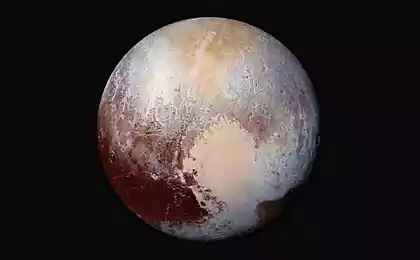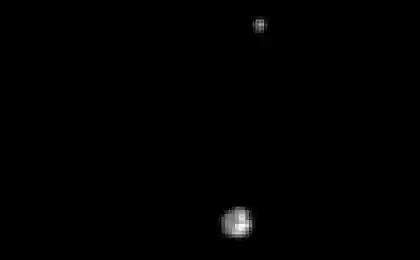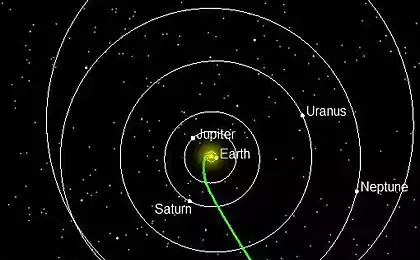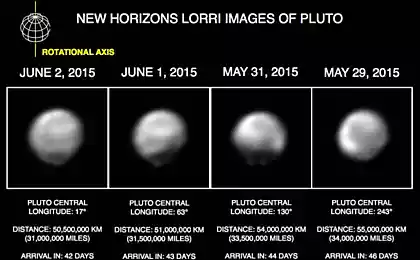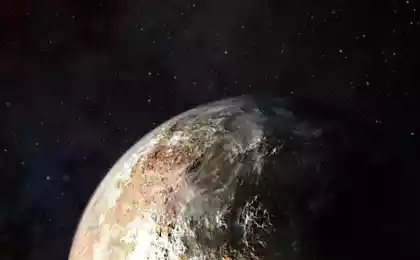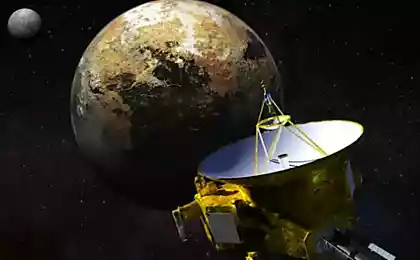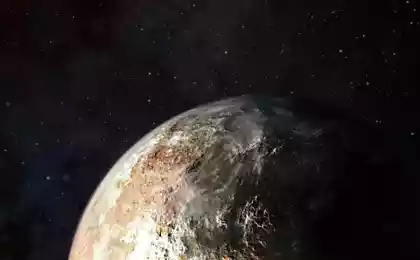602
Five and finds another mystery: the main results of the week rendezvous with Pluto New Horizons
To bring the first itogiSblizhenie New Horizons probe to Pluto at a distance of about 12, 5 thous. Km, of course, it was one of the most important events of the year - and received a response, which sold far beyond the world of astronomy and science. In the meantime, everyone is looking forward of sending to Earth the first images taken in the vicinity of the ice dwarf, remember the five major discoveries and one puzzle that brought New Horizons in the last week.

1. Pictures that New Horizons made on approach - from a distance of a little more than 700 thousand. km, - allowed to specify the size of the dwarf planet. Diameter it turned out a little (70 km) is larger than previously thought - absolutely 2370 km, which confirms the status of Pluto as the largest body in the distant Kuiper belt - and the largest outside the orbit of Neptune, the outermost planet of the solar system.
2. The objects on the surface of Pluto and its moons - Charon, Styx, Cerberus and Styx - can get the names of the Strugatsky and Cthulhu, Captain Nemo and Luke Skywalker. The International Astronomical Union (IAU), the organization responsible, including for assigning the official names of the heavenly bodies, has published "long list" of names that will be used in the geography of the ice and gloomy world.
3. On the surface of the cold dwarf seen a whole series of very suspicious dark spots located by the satellite Charon and extending to the "dark zone", which covers Pluto near the equator. The strange thing here is that they have very similar size (approximately 480 km) and shape. Unfortunately, when the New Horizons flew in the vicinity of Pluto, the spots were out of sight, so that further study seems to be delayed.
4. The existence of Pluto albeit subtle, but it is the atmosphere of this suspect before. Now, however, its existence can be considered as reliable evidence. Still five days before the approach New Horizons noticed emissions of nitrogen on the surface of the dwarf - it happened a lot sooner than expected experts at a distance of as much as 6 million kilometers instead of 2, 5 million km. This may indicate that a nitrogen "geysers" is more powerful than originally thought, or the atmosphere - is thinner and diluted.
5. Pluto itself and the world quite cold, so having him still and polar ice caps were moot. Now they are also able to observe: judging by the New Horizons, glaciers are composed of frozen together, solid methane and nitrogen.
But perhaps the main conclusion that can be drawn at the end of the week intriguing rendezvous with Pluto New Horizons, is that it is "live". A dwarf planet, apparently, still retains geological activity, reflected in a fairly young-looking mountain ranges and vast plains, which may result from the melting of methane and nitrogen. Moreover, the surface of these contain radioactive isotopes, which may indicate that not so long ago their stuff was lifted from the depths of Pluto.
From here arises the main mystery: how? .. The size of Pluto, in theory, are not sufficient to sustain life in a semi-liquid core. None of the Sun (in the form of radiation) or from any close giant planet (in the form of gravity) the extra energy it can not receive. "This will force many scientists to return to their slate," - commented the famous astrophysicist Alan Stern.
via naked-science.ru/article/sci/pyat-nakhodok-i-odna-zagadka-g

1. Pictures that New Horizons made on approach - from a distance of a little more than 700 thousand. km, - allowed to specify the size of the dwarf planet. Diameter it turned out a little (70 km) is larger than previously thought - absolutely 2370 km, which confirms the status of Pluto as the largest body in the distant Kuiper belt - and the largest outside the orbit of Neptune, the outermost planet of the solar system.
2. The objects on the surface of Pluto and its moons - Charon, Styx, Cerberus and Styx - can get the names of the Strugatsky and Cthulhu, Captain Nemo and Luke Skywalker. The International Astronomical Union (IAU), the organization responsible, including for assigning the official names of the heavenly bodies, has published "long list" of names that will be used in the geography of the ice and gloomy world.
3. On the surface of the cold dwarf seen a whole series of very suspicious dark spots located by the satellite Charon and extending to the "dark zone", which covers Pluto near the equator. The strange thing here is that they have very similar size (approximately 480 km) and shape. Unfortunately, when the New Horizons flew in the vicinity of Pluto, the spots were out of sight, so that further study seems to be delayed.
4. The existence of Pluto albeit subtle, but it is the atmosphere of this suspect before. Now, however, its existence can be considered as reliable evidence. Still five days before the approach New Horizons noticed emissions of nitrogen on the surface of the dwarf - it happened a lot sooner than expected experts at a distance of as much as 6 million kilometers instead of 2, 5 million km. This may indicate that a nitrogen "geysers" is more powerful than originally thought, or the atmosphere - is thinner and diluted.
5. Pluto itself and the world quite cold, so having him still and polar ice caps were moot. Now they are also able to observe: judging by the New Horizons, glaciers are composed of frozen together, solid methane and nitrogen.
But perhaps the main conclusion that can be drawn at the end of the week intriguing rendezvous with Pluto New Horizons, is that it is "live". A dwarf planet, apparently, still retains geological activity, reflected in a fairly young-looking mountain ranges and vast plains, which may result from the melting of methane and nitrogen. Moreover, the surface of these contain radioactive isotopes, which may indicate that not so long ago their stuff was lifted from the depths of Pluto.
From here arises the main mystery: how? .. The size of Pluto, in theory, are not sufficient to sustain life in a semi-liquid core. None of the Sun (in the form of radiation) or from any close giant planet (in the form of gravity) the extra energy it can not receive. "This will force many scientists to return to their slate," - commented the famous astrophysicist Alan Stern.
via naked-science.ru/article/sci/pyat-nakhodok-i-odna-zagadka-g

